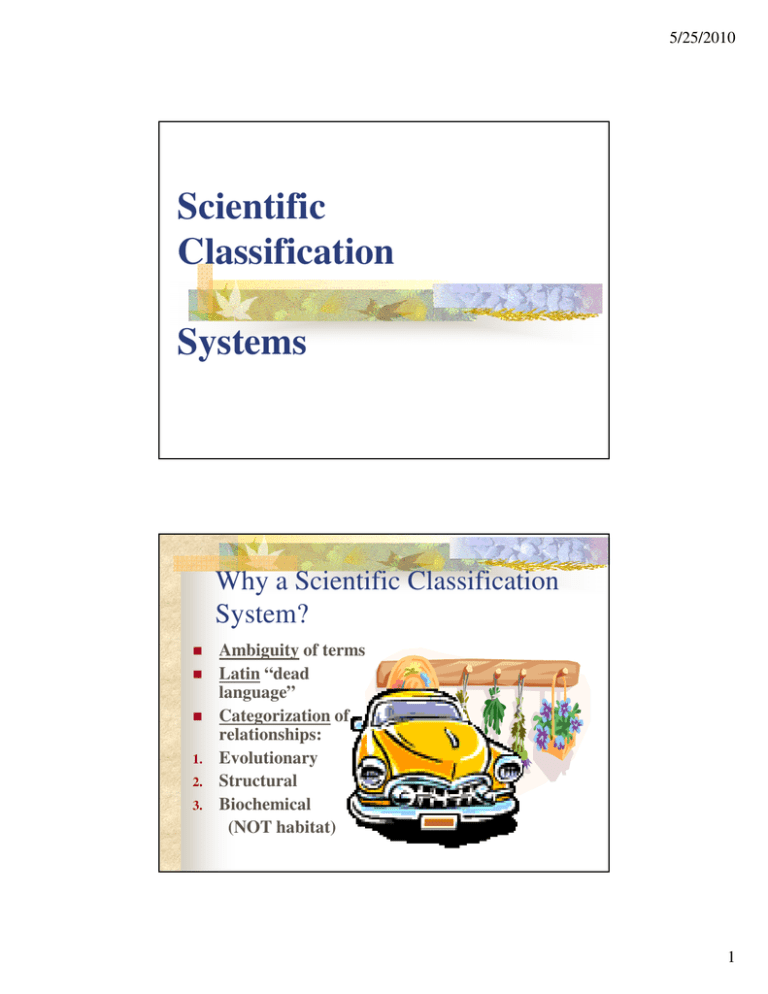
5/25/2010
Scientific
Classification
Systems
Why a Scientific Classification
System?
1.
2.
3.
Ambiguity of terms
Latin “dead
language”
Categorization of
relationships:
Evolutionary
Structural
Biochemical
(NOT habitat)
1
5/25/2010
7 Classification Groups:
Kingdom (most inclusive)
Phylum
Class
Order
Family
Genus
Species (most specific)
King
Phillip
Came
Over
From
Greece
Singing
5 Major Kingdoms:
1.
2.
3.
4.
5.
Monera
Protista
Fungi
Planta
Animalia
1 cell, prokaryotes
1 cell, eukaryotes &
algae
Multicelled, absorptive
feeders
Muticelled, autotrophs
Muticelled
heterotrophs
2
5/25/2010
Which is the most difficult to
assign?
Species:
Most specific
Successful
interbreeding
Fertile
offspring
Donkey + Horse=
Mule (infertile)
Which group has the largest #
organisms?
Kingdom:
Cell types
ProkaryotesE
ukaryotes
Cell number
Nutrition
Structures
3
5/25/2010
Plant Kingdom
Animal Kingdom
4
5/25/2010
Scientific Name:
Latin
Italics or underlined
Genus species
Homo sapien
Classification Criteria:
Biochemistry
Behavior
Hair Color
Genetic System
Evol. History
Nutrition
Molecular Make-up
Most (DNA)
Not very
Not very
Most
Most
Most
Not very
5
5/25/2010
Similar Categories:
Dolphin
Man
Fish
Whale
Bat
Similar Categories:
Grasshopper
Mosquito
Spider
Butterfly
6
5/25/2010
Did Man evolve from Apes?
No!!
Similar ancestor
Both:
Animalia
Cordata
Mammalia
Primates
Hommindes
The Piltdown Man was accepted as an
important archaeological find in 1912
because it seemed to bridge the
evolutionary gap between apes and
man. It was not until 1953 that, with
the help of fluorine dating tests, the
bones were determined to be the jaw
of an orangutan with the skull of a
man, both from the Middle Ages.
Here, Alvan Marston explains that it is
not a missing evolutionary link, but a
“most elaborate hoax.”
Hulton Deutsch
"Uncovering the Piltdown Hoax,"
Microsoft® Encarta® Encyclopedia 2000.
© 1993-1999 Microsoft Corporation. All
rights reserved.
7
5/25/2010
Mammals arise from Theraapsids
8
5/25/2010
Chimpanzees: distant relatives
Walking upright:
9
5/25/2010
Unlike their ape ancestors, early humans
had anatomical adaptations for upright
walking. The early human species
Australopithecus afarensis had a wide and
short pelvis and femurs (upper leg bones)
that angled inward toward the knees.
These adaptations provided side-to-side
balance and a fulcrum for the hip muscles
to hold the torso erect. In contrast, apes,
such as chimpanzees, have a tall and
narrow pelvis from which the femurs
extend straight down.
© Microsoft Corporation. All Rights
Reserved.
"Evolution of Upright Walking," Microsoft®
Lemurs: distant relatives
10
5/25/2010
The ruffed lemur lives in the eastern rain forests
of Madagascar. The lemurs and their relatives
are believed to have evolved in isolation from
the monkeys and apes after Africa became
separated from Madagascar over 50 million
years ago. Since the arrival of humans on
Madagascar over 2000 years ago, at least 14
species of lemurs are believed to have become
extinct.
Jean P. Varin/Jacana/Photo Researchers, Inc.
"Ruffed Lemur," Microsoft® Encarta® Encyclopedia 2000.
© 1993-1999 Microsoft Corporation. All rights reserved.
Piltdown “hoax”
11
5/25/2010
When Charles Darwin published The
Descent of Man in 1871, he
challenged the fundamental beliefs
of most people by asserting that
humans and apes had evolved from
a common ancestor. Many critics of
Darwin misunderstood his theory to
mean that people had descended
directly from apes. This caricature of
Charles Darwin as an ape appeared
in the London Sketch Book in 1874.
Mary Evans Picture Library/Science
Source/Photo Researchers, Inc.
"Caricature of Charles Darwin," Microsoft®
Encarta® Encyclopedia 2000. © 1993-1999
Microsoft Corporation. All rights reserved.
Homologous or Analogous
Stuctures?
12
5/25/2010
Homologous Structures:
Shark/Dolphin fin
Seal flipper/Fish fin
Fish tail/Whale fluke
Bat wing/Cat limb
Bird/Insect wing
Bird wing/reptile limb
Seal flipper/human
arm
Dog limb/whale flipper
No (cartilage/rays)
No (bones/rays)
Yes (bones/bones)
Yes (bones/bones)
Yes (bones/no bones)
Yes(bones/bones)
Yes(mammal bones)
Yes(mammal bones)
Structures that are similar due to
evolutionary origin, such as the forearm
bones of humans, birds, porpoises, and
elephants, are called homologous.
Structures that evolve separately to
perform a similar function are analogous.
The wings of birds, bats, and insects, for
example, have different embryological
origins but are all designed for flight.
© Microsoft Corporation. All Rights
Reserved.
"Analogous and Homologous Structures,"
Microsoft® Encarta® Encyclopedia 2000. © 19931999 Microsoft Corporation. All rights reserved.
13
5/25/2010
Family or Genus Relations?
Family:
Less closely related
Larger group
Genus:
More closely related
Precedes species=
interbreeding
Family:Felidae
Lions, tigers,
leopards
house cats,cheetahs,
ocelots
Genus: Panthera
Leopards (pardus)
Lion (leo)
Tigers (tigris)
Feline Family Members:
14
5/25/2010
Most authorities agree that the
domestic cat descended from
the Caffre cat, a small breed of
African wildcat. The Caffre cat
was domesticated in ancient
Egypt, possibly as early as 2500
BC.
G. G. Dimijian/Photo
Researchers, Inc.
"Caffre," Microsoft® Encarta® Encyclopedia 2000. © 1993-1999
Microsoft Corporation. All rights reserved.
Genus: Panthera (Lions &Tigers)
15
5/25/2010
Classification by characteristics:
Fossil Skulls
DNA Most Useful
Sequences
Hair
Samples Least
Pictures
16
5/25/2010
17





